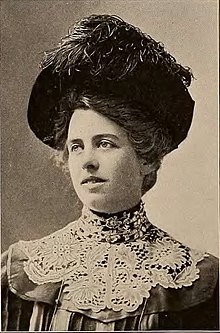Abbie Farwell Brown (August 21, 1871 – March 5, 1927)[1][2] was an American writer.
Abbie Farwell Brown | |
|---|---|
 | |
| Born | 21 August 1871 |
| Died | 5 March 1927 |
| Alma mater | |
| Occupation | Writer |

Early life and education
editBrown was born in Boston, Massachusetts, the first of two daughters of Benjamin F. Brown, a descendant of Isaac Allerton, and Clara Neal Brown, who contributed to The Youth's Companion. Her sister Ethel became an author and illustrator under the name Ann Underhill. Her family, for ten generations, had only resided in New England, and Brown herself spent her entire life in her family's Beacon Hill home.[2]
Brown was valedictorian of the Bowdoin School in 1886.[2][3] She then attended the Girls' Latin School, where she was friends with Josephine Preston Peabody. She was the driving force behind the newly created school newspaper, The Jabberwock, named by Brown after the poem by Lewis Carroll. They wrote to Carroll for permission to use the name and Carroll wrote back, wishing them "all success to the forthcoming magazine".[4][5] The school, now Boston Latin Academy, still publishes The Jabberwock. After graduating in 1891, she attended Radcliffe College, graduating in 1894.[1][2]
While at Girls' Latin School, she was contributing pieces to St. Nicholas Magazine, some illustrated by her sister. Starting in 1898, under the pen name Jean Neal she wrote articles for the St. Louis Globe-Democrat. She also wrote a one-act comedy called Quits (1896) set at a women's college.[1][2]
Career
editHer first children's book, The Book of Saints and Friendly Beasts (1900) was inspired by her first trip abroad, specifically by the carved choir stalls in Chester Cathedral depicting the life of Saint Werburgh. The book retells Christian stories of the animal encounters of various saints. Brown would write other collections retelling old tales for a contemporary child audience. Her In the Days of Giants (1902) featured stories from Norse mythology and remained a standard text in libraries for several generations. Tales of the Red Children (1909), co-written with James MacIntosh Bell, featured Canadian Indian folklore.[1][2]
Original stories by Brown include The Lonesomest Doll (1901), The Flower Princess (1904), John of the Woods (1909), and The Lucky Stone (1914). She wrote several volumes of children's poetry, including A Pocketful of Posies (1901) and Fresh Posies (1908). Her books of adult poetry, including Heart of New England (1920) and The Silver Stair (1926), were less successful.[1][2]
Brown wrote song lyrics for the Progressive Music Series by Silver, Burdett and Co. She and composer Mabel Wheeler Daniels wrote the song "On the Trail", which became the official song of the Girl Scouts of the USA. Daniels set Brown's war poem "Peace with a Sword" to music and it was performed by the Handel and Haydn Society in 1917. Brown's only juvenile biography was of a composer, The Boyhood of Edward MacDowell (1924).[2]
Brown was active in New England literary life. She edited the 20-volume Young Folks Library for the publisher Hall and Locke. She was a member of the Boston Authors Club, the Boston Drama League, the American Folklore Society, the Poetry Society of America, and was president of the New England Poetry Club.[2]
Death
editBrown died of cancer at the age of 55.[2]
Works
edit- The Book of Saints and Friendly Beasts (1900)
- The Lonesomest Doll (1901)
- In the Days of Giants: A Book of Norse Tales (1902)
- A Pocketful of Posies (1902)
- The Curious Book of Birds (1903)
- The Flower Princess (1904)
- The Star Jewels, and Other Wonders (1905)
- Brothers and Sisters (1906)
- Friends and Cousins (1907)
- John of the Woods (1909)
- The Christmas Angel (1910)
- Songs of Sixpence (1914)
- Kisington Town (1915)
- Surprise House (1917)
- Heart of New England (1920)
- Round Robin (1921)
- The Lights of Beacon Hill: A Christmas Message (1922)
- The Silver Stair: Poems (1926)
References
edit- ^ a b c d e Moe, Phyllis (1979). "Abbie Farwell Brown". In Mainiero, Lina (ed.). American Women Writers: A Critical Reference Guide from Colonial Times to the Present. Vol. 1. New York: Frederick Ungar Publishing Co. pp. 247–49.
- ^ a b c d e f g h i j Edward T. James; Janet Wilson James; Paul S. Boyer (1971). Notable American Women, 1607–1950: A Biographical Dictionary. Harvard University Press. pp. 247–49. ISBN 978-0-674-62734-5.
- ^ Nichols-Wellington, Leah L. (1912). History of the Bowdoin School, 1821–1907. Manchester, New Hampshire: Ruemely Press. p. 147.
- ^ Sharon M. Harris; Ellen Gruber Garvey (2004). Blue Pencils and Hidden Hands. UPNE. ISBN 978-1-55553-613-8.
- ^ "The History of the Jabberwock - Established February 1888". Girls' Latin School and Boston Latin Academy Alumni Association. 2010. Archived from the original on January 20, 2013. Retrieved March 3, 2013.
External links
edit- Works by or about Abbie Farwell Brown at Wikisource
- Media related to Abbie Farwell Brown at Wikimedia Commons
- Abbie Farwell Brown Papers, Schlesinger Library, Harvard University
- Works by Abbie Farwell Brown at Project Gutenberg
- Works by or about Abbie Farwell Brown at the Internet Archive
- Works by Abbie Farwell Brown at LibriVox (public domain audiobooks)
- Abbie Farwell Brown at Find a Grave
- MyNDIR (My Norse Digital Image Repository)